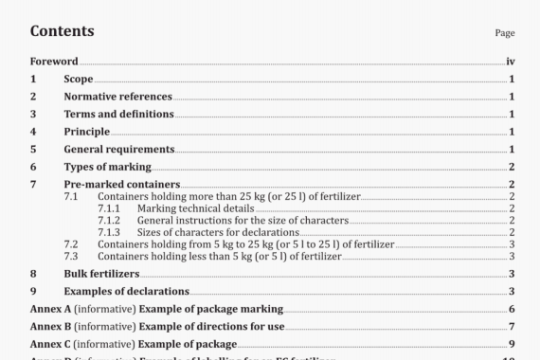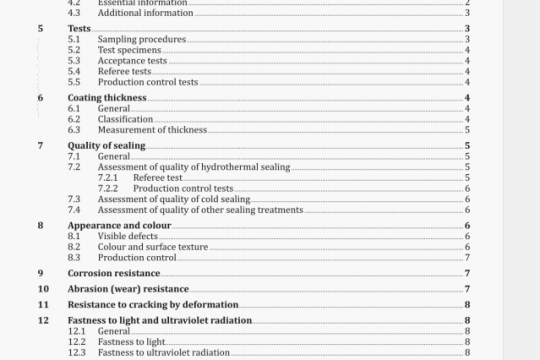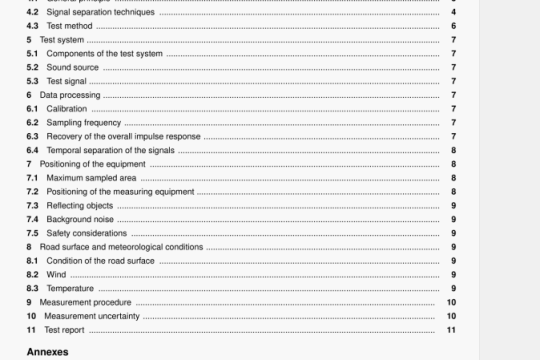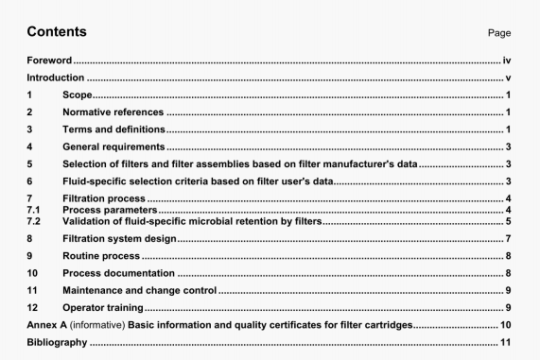ISO 354:2003 pdf download
ISO 354:2003 pdf download.Acoustics – Measurement of sound absorption in a reverberation room.
6.2.2.2 Discrete objects (e.g. chairs, free-standing screens or persons) shall be installed for the test in the same manner as they are typically installed in practice. For example, chairs or free-standing screens shall rest on the floor, but they shall not be closer than 1 m to any other boundary. Space absorbers shall be mounted at least 1 m from any boundary or room diffusers and at least 1 m from any microphone. Office screens shall be mounted as individual objects.
6.2.2.3 A test specimen shall comprise a sufficient number of individual objects (in general, at least three) to provide a measurable change in the equivalent sound absorption area of the room greater than 1 m2, but not more than 12 m2. If the volume, V, of the room is greater than 200 m3, these values shall be increased by the factor (V1200 rn3)2”3. Objects normally treated as individual objects shall be arranged randomly, spaced at least 2 m apart. If the test specimen comprises only one object, it shall be tested in at least three locations, at least 2 m apart, and the results shall be averaged.
6.3 Temperature and relative humidity
6.3.1 Changes in temperature and relative humidity during the course of a measurement can have a large effect on the measured reverberation time, especially at high frequencies and at low relative humidities. The changes are described quantitatively in ISO 9613-1.
6.3.2 Measurements should be performed in the empty room and in the room containing the test specimen under conditions of temperature and relative humidity that are almost the same so that the adjustments due to air absorption do not differ significantly. In any case, the relative humidity in the room shall be at least 30 % and max. 90 % and the temperature shall be at least 15 °C during the whole test. For all measurements, the corrections for the change in air absorption as described in 8.1.2.3 shall be applied.
Allow the test specimen to reach equilibrium with respect to temperature and relative humidity in the room before tests are carried out.
7 Measurement of reverberation time
7.1 General
7.1.1 Introduction
Two methods of measuring decay curves are described in this International Standard: the interrupted noise method and the integrated impulse response method. The decay curve measured with the interrupted noise method is the result of a statistical process, and averaging several decay curves or reverberation times measured at one microphone/loudspeaker position is mandatory in order to obtain a suitable repeatability. The integrated impulse response of a room is a deterministic function and not prone to statistical deviations, so no averaging is necessary. However, it requires more sophisticated instrumentation and data processing than the interrupted noise method.
7.1.2 Microphones and microphone positions
The directivity characteristic of the microphones used for the measurement shall be omnidirectional. The measurements shall be made with different microphone positions which are at least 1,5 m apart, 2 m from any sound source and 1 m from any room surface and the test specimen. Decay curves measured at different microphone positions shall not be combined in any way.
7.1.3 Source positions
The sound in the reverberation room shall be generated by a sound source with an omnidirectional radiation pattern. Different sound source positions which are at least 3 m apart shall be used.
7.1.4 Number of microphone and loudspeaker positions
The number of spatially independent measured decay curves shall be at least 12. Therefore the number of microphone positions times the number of sound source positions shall be at least 12. The minimum number of microphone positions shall be three, the minimum number of sound source positions shall be two. It is permissible to use more than one sound source simultaneously provided the difference in the radiated power is within a tolerance band of 3 dB for each one-third-octave band. If more than one sound source is used for excitation simultaneously, the number of spatially independent measured decay curves may be reduced to six.




